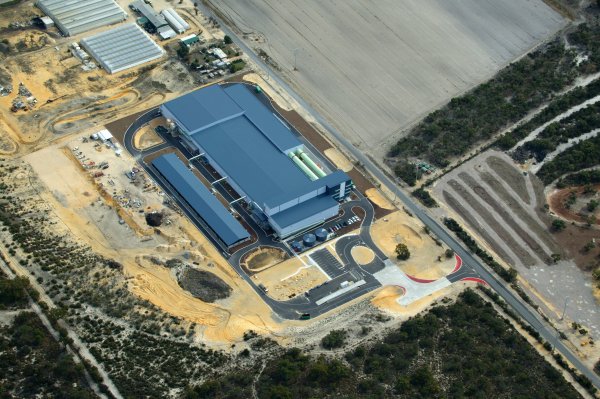The ARRT of recycling
Tuesday, 26 October, 2010
Despite rising global concern on climate change and increasing scarcity of natural resources, Australia is sending over 21 million tonnes of waste to landfill every year. Technologies exist today that enable councils and businesses to deliver on their sustainability goals and greenhouse gas (GHG) footprint reductions. SITA Environmental Solutions (SITA) advanced resource recovery technology (ARRT) facilities offer a good alternative to process and re-use this ‘wasted’ landfilled feedstock.

Most landfilled ‘waste’ is a waste, as more than half of it is made up of valuable organic material. These organics decompose in landfill, producing methane, a potent greenhouse gas 25 times more powerful than CO2. Raw organics should not be landfilled as they are valuable resources that can be processed into high-quality compost and re-used on Australian infertile soils. As well as organics, dry high-calorific materials such as plastics and timber are also sent to landfill - another ‘wasted’ opportunity, as ‘ARRTs’ exist to capture their embodied energy to produce alternative fuels, and therefore renewable green energy.
As an experienced provider of ARRT solutions, SITA successfully operates over half of these advanced resource recovery facilities around Australia. These facilities can divert up to 60% of the mixed municipal waste stream, converting organic materials to fit-for-purpose, quality compost for land application, as well as recovering valuable recyclable materials. The residual or remaining 40%, which is not compostable material or not economically recyclable, goes to landfill.
Currently, only about 5% of mixed municipal solid waste is processed through ARRT facilities in Australia. By all councils adopting best resource recovery practices, approximately 7 million tonnes of organics could be diverted from landfills, however, there would still be residuals going to landfill every year. These residuals can now also be processed into process engineered fuel (PEF) and re-used, with the added benefit of green energy production, reaching a total diversion from landfill of up to 80%.

The PEF model has a critical place within the ARRT by increasing landfill diversion rates from residual mixed solid waste streams. SITA owns and operates the Adelaide SITA-ResourceCo recovery facility which produces alternative PEF. This facility produces an engineered fuel product from mixed commercial and industrial (C&I), as well as construction and demolition (C&D) waste streams, converting around 150,000 tpa into recyclables and PEF. Approximately 80,000 tpa of this PEF is used as an alternative fuel at the Adelaide Brighton Cement kiln in Adelaide. The landfill diversion of this facility is over 90%. This facility has been supported by the South Australian state government and the operation is monitored by the SA EPA. SITA-ResourceCo is also the first Australian waste-to-energy company to be certified Greenhouse Friendly by the federal Department of Climate Change.
Recent tests were performed by SITA to capture the high-calorific residual materials from its mixed waste ARRT facilities and reprocess them through the SITA-ResourceCo technology to be transformed into PEF. These tests have illustrated that high-calorific residuals can be separated in the mechanical sorting and refining processes that occur in SITA’s mixed waste ARRT facilities to produce a PEF - with an average calorific value of 20 to 25 MJ/kg, similar in energy content to black coal - by the SITA-ResourceCo facility.
SITA will be replicating the successful South Australian SITA-ResourceCo operation in other states of Australia. This initiative will significantly lift the landfill diversion rate for SITA’s ARRT facilities up to 80% for mixed waste, and support councils and businesses as they focus on reducing their GHG footprints.

The environmental benefit of using PEF as a viable substitute for fossil fuels is already well recognised and widely implemented in Europe. Even staunch former opponents to waste-to-energy plants such as Greenpeace in Germany now recognise the benefits of combusting specifically produced, high-calorific residuals. Some European plants have replaced nearly 100% of their fuel needs with PEF. Their use in Australia makes even more sense, given the strong reliance on the GHG-producing coal power plants that dominate the market.
Prospering in a carbon-constrained world will increasingly involve having to rely on renewable energy solutions for all industries in Australia. Therefore, power stations and cement kilns can significantly benefit from the increase in production of quality-controlled alternative fuel such as PEF. Dedicated green power stations can also use PEF to produce electricity as well as thermal power for heating and cooling of industrial areas and housing estates.
Increasing landfill levies, reduced landfill capacity and an emphasis on reducing GHG emissions position ARRTs as being no longer an alternative, but a mainstream component of the ‘waste’ management decision process.
The combination of SITA’s ARRTs with the production of PEF represents a cost-effective way for councils and businesses to achieve high overall diversion of their mixed waste from landfill.
Partnership brings innovative fuel solutions to Gippsland
A study by European Energy Australia and Opal at the latter's Maryvale Paper Mill will assess...
Data centres — a missed opportunity for sustainability
The question is no longer whether we need data centres, but how we plan, locate and govern...
Sodium-ion battery may provide greener energy
Scientists say sodium-ion batteries may be the answer to the future of sustainable energy storage...







